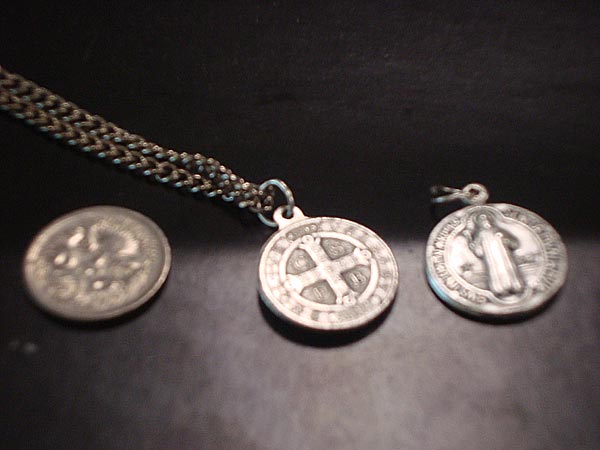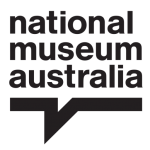by Oliver Cosgrove (guest author) on 7 March, 2011
Here Oliver Cosgrove shares the St Benedict’s Medal which was given to all the boys at Boys’ Town, Bindoon, WA as well as an article from 1955 written about the Medal. The article sadly makes light of child slave labour at Bindoon.
In the August 21, 1955 edition of the publication Pax (Latin for “peace”), an article reads:
…a Freemason had insisted that the possession of the Medal Cross of St Benedict had been the cause of much good luck at the Races! The Freemason was indeed sincere. But when today in fact was related to us from Bindoon we felt that this was more in keeping with what we would expect from the great Patriarch.
At Boys’ Town, Bindoon, all lads had been issued with St Benedict’s Medal by the chaplain, and one lad at least certainly wearing his treasure round his neck. While at work on the first floor of one of the new buildings some fifteen feet from mother earth, this lad fell. To make matters worse it was not mother earth who received the falling boy, but a heap of rough-edged rocks. The spectators were greatly alarmed and expected serious injury, to say the least. But what was their surprise when they saw the lad pick himself up immediately – and on enquiry they got the reply: ‘I’m alright – of course I’m alright. I’m wearing the Medal of St Benedict.”
Also from Pax 31 July, 1955:
St Benedict’s Medal Described
(By Dom Justin Bruce O.S.B., N. N.)
The essential parts of the Medal of St Benedict are the Cross, the image of St. Benedict, and certain letters which we mean to explain. The shape of the Medal is evidently not important. To avoid confusion we must remember that one Medal, known as Ordinary Medal of St Benedict was approved, and richly indulged by Pope Benedict XIV in 1742, and a second was struck and approved by Pope Pius IX in 1877 in anticipation of celebrations in honour of St Benedict on the 14th centenary of his birth, which occurred in 1880.
A glance at the Ordinary Medal of St Benedict will show a Cross engraved on one side, on the arms of which certain letters appear, while more letters are seen in the angles of the Cross, and also in the border around the edge of the Medal. On the other side there is an image of St. Benedict. These are the essentials for the Ordinary Medal is genuine.
The letters: In the angles of the Cross we read the letters C. S. P. B. which stand for Crix Sancti Patria Benedicti (“The Cross of the holy father benedict”). On the perpendicular bar of the Cross are found the letters C. S. S. M. L. They signify: Crux Sacra Sit Mihi Lux (“May the holy Cross be my light”).
The letters on the horizontal bar of the Cross are: N. D. S. M. D. Non Draco Sit Mihi Dux (“May the devil never be my guide”).
Obviously these words express simply a renewal of our baptismal vows, by which we solemnly declare ourselves followers of the Cross of Christ, renouncing at the same time the devil and his snares. Around the margin….are the following letters, beginning at the top right hand:
V. S. N. S. M. V. S. M. Q. L. I. V. B.
and stand for the following verses:
Vade Retro, Satana:
Numquam Suade Mihi Vana
Sunt Mala Quae Libas
Ipse Venena Bibas
(“Begone Satan. Tempt me not with antics. What thou offerest is evil; drink thou thyself the poison”).
At the top of the same side of the Medal, can be seen the three letters I.H.S. which signify the Holy Name of Jesus.
This is the Medal of St. Benedict. If we carry it on our person, we are continuously, if implicitly, making an act of renunciation of Satan. ……..
The second Medal above mentioned is known as the Jubilee Medal. It differs from the Ordinary Medal in that it has attached to it not only the indulgences of the latter, but has others added besides. On the side which bears St. Benedict’s image we see the words: “Eius in obtu nostro praesentia muniamur” (“May we be strengthened by his presence at the hour of our death”). Also the Benedictine Motto “Pax” (Peace) will always be found engraved on the side of the Jubilee Medal which bears the Cross and the letters.



I should have made it clear that the magazine “Pax” was the official journal of the Abbey Nullius, (i.e., an abbey that is beyond the jurisdiction of the local bishop) of New Norcia. Bindoon was situated in the Abbey territory and the Abbot of New Norcia was, in effect, the local bishop, having jurisdiction over the teaching of Christian Doctrine at Bindoon (and nothing else!).
Saw movie today ” Oranges and Sunshine ”
Most disturbing did not know about this until today ……………..
Was there a ship of Children orphans from the UK sunk on ther journey to
Australia prior to 1940………. does anyone know ?
Yes, the ship was called “City of Benares”. It was bound for North America and carried children being evacuated for the duration of the war. Some came to Australia. The government-sponsored scheme allowed parents to have their children evacuates: the children were not from orphanages. The ship
was torpedoed by a U
Your are a perpetual font of knowledge Oliver!
Thank you so much for responding to Noreen’s query.
The ship City of Benares had children being evacuated from UK to North America under a government scheme. The evacuees were not from orphanages. The torpedoing sunk not only the ship and some 60 children but the whole scheme. Some children were sent to Australia under the scheme. They were billetted out to people’s homes.
The scheme was run by the Children’s Overseas Reception Board. The happy knack that Australians have in conferring nicknames meant that these kids were called Corblimeys. They were repatriated at war’s end and some returned as migrants.
I too saw the movie last weekend. I knew the Catholic Church was capable of great horrors but this was in ‘our time’ and not in the dark ages. I knew little about this place. I do not want to know any more.
Is Oliver saying that the local Bishop and the abbot’s
superiors had no moral responsibility for the terrible treatment of the boys?
Of course Oliver can answer for himself but I think his point is drawing attention to the fact that these Catholic leaders didn’t fulfil their duty of care.
Correct me if I’m wrong Oliver!
Thank you for your comment Marshall. Great to have your participation on our website.
It’s complex in the case of child migrants, and at the time Bindoon held only child migrants. It went like this: in canon law the Christian Brothers and Sisters of Mercy were (and are) orders of Pontifical right. The local bishop had no say in how the order ran its lawful affairs. The local bishop (or Ordinary, to give the correct title) could examine institutions to see if they were teaching Christian Doctrine, and could examine them to see if they were obeying their Pontifical (or Papal) constitution. He was to report defects to the order’s heads. When it came to child migrants the Archbishop signed indentures under the Commonwealth Immigration (Guardianship of Children) Act, 1946 stating that he would be custodian under that Act’s Regulations and would treat the children in the manner prescribed by the State’s Child Welfare Act, but the Federal Minister for Immigration was the Guardian. That guardianship was delegated (except for power of further delegation) to the Undersecretary Lands and Immigration in WA and later to the Assistant Director Child Welfare Department. Thus, the Bindoon Christian Brothers, although in the abbatial territory of the Abbot of New Norcia who was what I will call the sovereign church chief of his territory was not the custodian of the children at Bindoon, the Perth ‘sovereign church chief’ was. And the State government child welfare authorities were always behind the 8-ball of this administrative mare’s nest. There were other constraints but I haven’t space to discuss here. I don’t want to discuss the moral obligations of others.
My two uncles went to Bindoon when they came from Malta on paid passage. They were sent there because in Malta they were told it was a good Catholic School and that they would be looked after while my granfather found a house. The stories my uncle has shared with us is sad of how they were treated there. When they sent letters home “they” edited them. If my grandmother knew I don’t think she would’ve been able to live with herself. When my grandma came out with the rest of the family into their new home, the Christian Brothers had the hide to come and see if her place was livable. Of course it was,she was Maltese, very loving, very clean and very generous. I know they hold sad memories and scars from that time.
Thank you Janelle,
I am so sorry that your grandma’s trust was betrayed.
As a child I watched my parents pack Food for Britain parcels to send to Dads brother and family. Therefore I was interested in this part of history.
Saw the film Oranges and Sunshine yesterday- 14th August 2011 They said in it that there were 130,000 children sent over in the scheme not 7000. Was the large building in the film (which looked as if it was a painted back drop) supposed to be New Norcia or Bindoon? I have been to New Norcia in 1996 although there was some similarity I didn’t think it looked as impressive as that.
My three cousins who lived in Bristol England were to be sent out in that ship that got torpedoed, but my Aunt changed here mind about them going. How is that for mothers instinct!
I have since met them and I can now tell them which boat was torpedoed. I thought that there were more than 60 children involved though.
Thankyou for this information. Glad Bailey
Hi Glad,
Thank you for your comment. Yes, there were 130,000 Child Migrants from Britain and Malta and 7,000 of these children were sent to Australia. Others were sent to Canada, New Zealand and South Africa.
Your Aunt had wonderful intuition!
Thanks Glad.